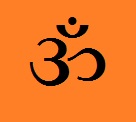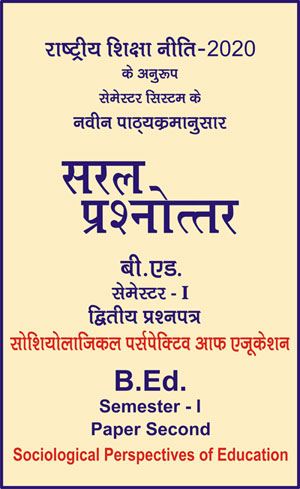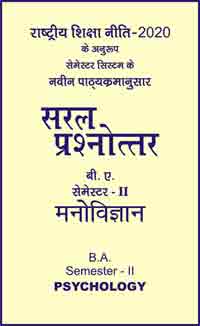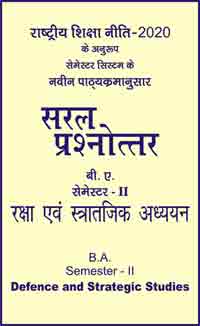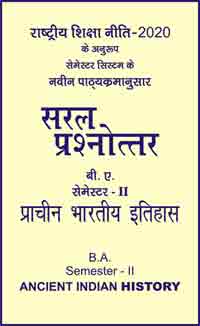|
बी एड - एम एड >> बी.एड. सेमेस्टर-1 प्रश्नपत्र-II - सोशियोलाजिकल पर्सपेक्टिव आफ एजूकेशन बी.एड. सेमेस्टर-1 प्रश्नपत्र-II - सोशियोलाजिकल पर्सपेक्टिव आफ एजूकेशनसरल प्रश्नोत्तर समूह
|
5 पाठक हैं |
|||||||
बी.एड. सेमेस्टर-1 प्रश्नपत्र-II - सोशियोलाजिकल पर्सपेक्टिव आफ एजूकेशन (अंग्रेजी भाषा मे)
Question- Explain and discuss unity and diversity in Indian Culture. What are the important elements in Indian Culture ?
Ans.
The ideal of cultural unity is not new to India, it is a concept which has been common to Indians of the past. The seers who gave birth to Indian culture were perfectly aware of the unity in India, the unity that derives from many common and uniform elements. The unity can be comprehended easily by understanding the unity that exists in various fields.
(1) Geographical Unity : India, like every other country, has its own fixed boundaries that are natural. India is limited within boundaries that are evidence of a geographical unity, a unity which baffles the scholars who themselves live in small European countries and find it difficult to comprehend how such a large country with so much variety of nature can be united.
The very name Bharatvarsha implies a historical significance that symbolizes unity. The name is not born of geographical necessity, but is concerned with the ideal of Chakravarti. This name, the chief characteristic of which is unity, has always occupied an important place in the minds of religious thinkers, political philosophers and poets since each has conceived of the country as a single expanse from the Himalayas to Cope Comorin, a country ruled by one king. It is for this unified entity that they have expressed admiration and love. Much of the literature of the past has praise for those kings and emperors who had tried to extend their respective empires from the Himalayas to Cape Comorin and form the Brahmaputra in the East to the Indus in the West. Some of them achieved success in their endeavours. Even in the medieval period, each successive ruler treated the country as a geographical unit and tried to extend his rule over the entire expanse of land.
(2) Religious Unity : Although the various religious groups in India present elements of external difference, it is not impossible to trace elements common to all. Each religious group exhibits one single feeling, each accepts the truth of immortality of soul, temporary nature of world, rebirth; the law of Karma, monism, salvation, nirvana, contemplation and all the other things that go to make up the religious paraphernalia. There are differences in the way these elements are treated but each religion preaches a fundamentally single religious faith and shares a belief in the purity and values of life, faith in an invisible power, benevolence, piety, honesty and liberality, with every other religious system. The rituals are almost common to every form of religion in the country. If one were to look no further than the followers of Shiva and Vishnu one would find that although they pray to different gods, they are spread out all over the country and they have erected temples wherever they have gone. These temples are to be found not only in the ice-bound breaches of the Himalayas and fertile plains of the Ganges but also in the deltas of Tunghbadra, Cauvery and Krishna. Ramayana and Mahabharata, the epics, are read as avidly in the Punjab and Kashmir as they are in the South. The legends of Rama and Krishna are sung and repeated with equal fervour among people who speak Hindi and among those who speak such language as Tamil, Telugu and the rest. Equal respect is given everywhere to the Gita, the Vedas, Puranas and other scriptures in India.
(3) Cultural Unity : Indian culture possesses a fundamental unity, a unity the impress of which can be found on the literature and thought of different communities, despite the obvious difference in customs and traditions. The fundamental approach to literature, philosophy, traditions and customs is typically Indian. The basis of the social and cultural unity of the country is common to every group. One finds this common element lurking out from behind the apparent differences of social intercourse, religious rites, ceremonies and the rest of it. All groups and communities unanimously accept the inviolable nature of family, sanctity of sanskaras and of the kitchen are commonly accepted. Many of the festivals are celebrated all over the country in one and the same manner. This is possible only because a cultural unity does exist.
(4) Unity of Emotion : It has been difficult to discover why the South Indian languages have remained confined to that area. A large number of languages make it difficult to promote a national unity, while a large number of races make this even more difficult. Both these elements are present in India, but since Sanskrit was the common base of the Indian languages, the problem of linguistic multiplicity has been solved. People of the North as well as of the South accepted Sanskrit. At the same time Sanskrit became the language of Hindu culture and all classics were composed in this language. It was in the protective atmosphere of Hindu culture and Sanskrit that this land of many languages became one nation.
Sanskrit was the ancient language of India, used in common converse many centuries before Christ, but in three or four centuries B.C. Prakrat language spread in the country, a language which resembles Sanskrit. At that time Sanskrit was the language of the scholars and Prakrat that of the common people. In the dramas produced during the first century B.C., a mixture of Sanskrit and Prakrat is found in the works of Kalidas and Ashvaghosh. In these dramas it was the convention for the educated person to speak Sanskrit and for uneducated to converse in Prakrat. This is clear evidence of the fact that Prakrat was the language of the uneducated masses of India. Ashok promoted the spread of religion on a door to door basis through Buddhist monks, the language being Prakrat. Later on Pali replaced Prakrat. Much literature was produced in Pali, Buddhist philosophical and religious texts known as Jataka and Tripitaka were composed in Pali. Jain literature was also composed in the same language.
(5) Political Unity : The political unity of the country is, in fact, an offshoot of the religious and cultural unity that has characterised India in the past. It cannot be denied that in moments of heat and controversy the various territorial princes rebelled against the central authority, but each one realized the value of the ideal of universal overlord. Kings released horses to be called universal overlords (Chakravarti) and Vedic literature contains numerous instances in which kings did achieve this position. Some of these kings are Prathu, Dilip, Aj, Dashrath, Sagar, Yayaati, Mandhata and Yudhisthira. At times it was observed that kings declared war on other kings for no purpose other than to gain the title of universal overlord. But in all such conflicts the motive was not of material or psychological advantage but the desire to unite the entire country under a central authority. Never has any Indian ruler transcended the natural boundaries of the country to attack any external power, with any expansionist ambition. But one of the marked tendencies of all political sovereigns within the country has been to bring the largest tract of land under their control and to establish as large a political unit as possible. Chandra Gupta, Ashok and Samudra Gupta, among other emperors, claimed the title of universal overlord by performing what is known as the ashvamedha yagya. This notion of universal by performing what is known at the ashvamedha yagya. This notion of universal overlordship is very old. The presence of various terms synonymous with universal overlordship in Vedic literature and the fact that religious practices such as the ashvamedha yagya indicates that even the most ancient ruler in India was fired with an ambition of ruling over the entire nation. Many of them wanted to create political unity and some of them did succeed to some extent.
Even in the most ancient and dark periods the Hindus have always been proponents of a fundamental unity in spite of surface dissimilarities. This basic trait inherent in Hindu culture has influenced every Hindu. There has never been any conflict between the proponents of different religions and each has continued to blow his own trumpet without interference from any other. All these saints have evinced the feeling of belonging to each other, a sense of identity of purpose and emotion. The interest that many Muslims have taken in Indian religion, philosophy, science and culture is evidence of the fact that cultural unity has always marked the Indian life.
Important and Permanent Elements in Indian Culture
The following are important and permanent elements in Indian culture :
- Indian Culture is Religion-Oriented : Indian culture is founded on religion but the obvious question is, what is religion ? ‘Dharma’ has been liberally interpreted in the Indian context for it does not coincide with the English term religion : the latter denoting the external rites and performances. In Indian culture the word ‘Dharma’ includes the performances of rites, but it further comprehends cultural organization and spirituality. It is so comprehensive that it is placed above other aims in life. It is the thread which ties the Indians together, and according to Indian culture, it is the element that distinguishes man from beast.
-
Indian Culture is Spiritual : The basic aim of Indian culture is self-knowledge. The originators of Indian culture, the seers and the mendicants came to the conclusion that man should know himself because that is the only way in which the truths of the world can be known with any fullness. It is for this reason that Indian religion is more introverted than extroverted, more tendencious towards the spiritual than towards the material. Sri Aurobindo has rightly stated that spirituality is the key to the Indian mind. It is this spirituality which has helped Indian culture to retain its novelty among all the other cultures. Spiritually is one sphere in which Indian culture has led all the rest. All the theistic and atheistic philosophies that go to make up Indian culture are imbued with the idea of spirituality. Religion and Philosophy are important elements in Indian culture, and both these have influenced Indian culture and civilization greatly. Everything carries a tinge of religion and philosophy in India.
-
Religious Tolerance : Religious tolerance has been a common feature of the Indian culture. Religion was preached and propagated but it never became a source of conflict and violence. People tried to appreciate common elements of different religions and thus understood essential unity of religions.
-
Synthetic Spirit : Since its very beginning Indian culture had been synthetic in its spirit. Aryans, the founders of Indian culture, gave it a capacity to assimilate the foreign elements which came in India from time to time. Even the inner revolts as that of Buddhism which arose within it gradually subsided and merged in it. Hinduism, the essence of Indian culture, has accepted many different religions into its fold and has only gained thereby. Even the Muslim religion could not escape the synthesizing tendency of Hindu culture.
-
Power of Adaptation : Darwin argued that only the fittest could survive in this universe, and the species who are weak are eliminated by circumstances. Those who are powerful change the circumstances to suit their own convenience. The fact that Indian culture is alive today proves that it has greater power than the other cultures. Innumerable social upheavals and political changes have taken place in India since the Vedic age to the present day, but Indian culture has always managed to adapt circumstances to its own requirements.
-
Comprehensive Viewpoint : The viewpoint of Indian culture has never been one-sided; instead it has always been integral in its approach to life. It stresses the importance of both the material and the spiritual aspects and advocates the advances and development of literature, music, art, science and the other disciplines. This is clear evidence of the comprehensive viewpoint. Indian culture has accepted four primary values, and in this scale earning and sex have been placed on an equal footing with duty and salvation.
|
|||||




